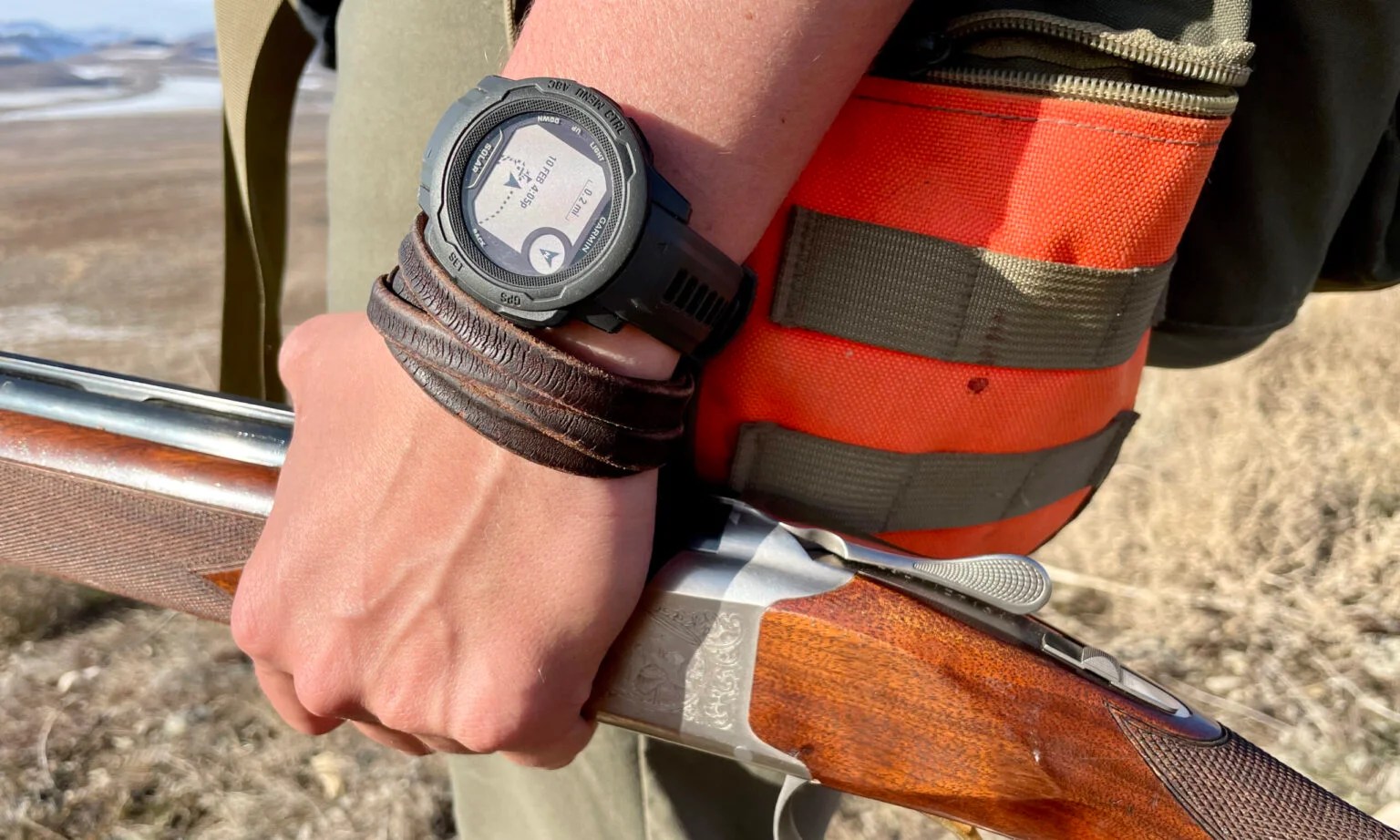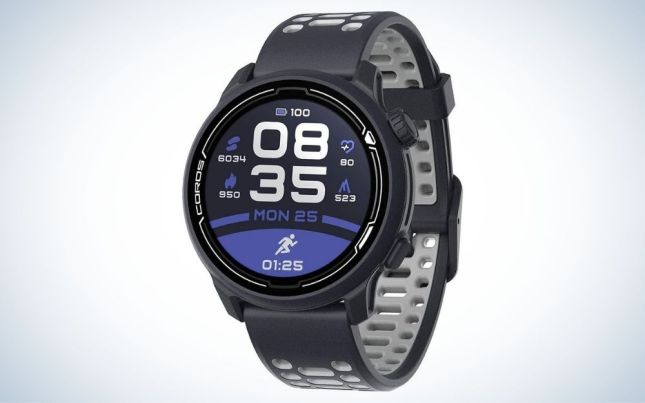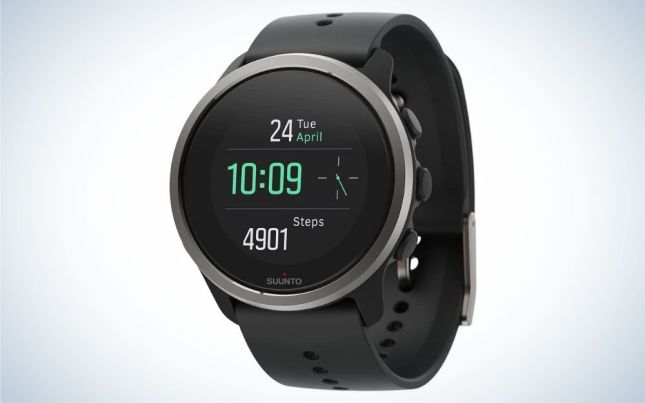We may earn revenue from the products available on this page and participate in affiliate programs. Learn More ›
At first glance, newer technology like GPS watches may seem to take away from the experience you get from the outdoors. Too much technology in a place many seek out solitude. However, those who understand these watches’ added power know they’re a valuable tool that allows everyone from hikers to hunters to explore more terrain and new areas. Their features include heart rate monitoring, turn-by-turn directions, mapping, solar charging, and connecting to your primary GPS. They also tell time. Here’s a look at some of the best GPS watches available on the market now.
- Best Overall: Garmin Fenix 7 Sapphire Solar
- Best for Hunting: Garmin Instinct Solar 2
- Best for Running: Coros Pace 2
- Best for Backpacking: Suunto 5 Peak
How I Tested the Best GPS Watches
While many watches are designed for different uses, I tried to keep three clear tests for use: running, biking, and something on the water. Most of these watches are waterproof, and that proved to be true for each one.
After each exercise, I also reviewed the data received for accuracy and just a basic understanding of what the watch was able to collect.
Almost all GPS watches include an app on your smartphone and reviewing these for ease of use was another important step in comparing each watch and understanding its strong suits and what the watches were designed for.
Most claim to be waterproof, and none of the watches I tested were affected by getting wet, but I didn’t keep any of them underwater for a substantial amount of time.
Finally, each watch was tested simply by wearing them throughout the day. Whether that was just tracking steps or monitoring a heart rate, it was interesting to see the data breakdown.
Best GPS Watches: Reviews & Recommendations
Best Overall: Garmin Fenix 7 Sapphire Solar
Key Features
- Solar powered (up to 37 days of battery life in smartwatch mode)
- Three different size options
- Touch screen
- Flashlight (on large “X” size)
- Multi-band GPS and preloaded Topo maps (on Sapphire model only)
- Format settings on your phone
- Variety of health tracking features and programs
Pros
- Incredible number of features and apps
- Accurate GPS mapping and easy navigation
- Compatible with other Garmin devices like dog e-collars and inReach
- Rugged, durable construction
- Long battery life
Cons
- Pricey
- Hefty
- Not for beginner smartwatch users
If James Bond was into outdoor recreation and fitness, the Garmin Fenix 7 Sapphire Solar would be his watch. Garmin’s new line of Fenix watches includes three different models (Standard, Solar, Sapphire Solar). Each model is offered in three different sizes. There are too many variations to get into, so I’ll stick with the model I tested, the Fenix 7 Sapphire Solar, which is the high-end version. This model has sapphire lens material and titanium bezel material. It has a larger and more efficient solar panel than previous Garmin models.
I’ve used this watch for a little over a month and am still digging into all of its features. On the upside, general setup was quick and painless. I navigated through the watches setting options and then paired it with my phone through Garmin’s Connect app. The first thing I did was take it for a run through one of my regular routes and was happy to see the watch tracked perfectly. As it should. The Sapphire Solar uses multi-band GPS, which can access more than one range of frequencies from different constellations of satellites (most GPS systems use a single connection to the satellites). In other words, it utilizes more powerful GPS technology that should mean faster and more accurate navigation. While navigating on hikes, the touch-screen feature made moving around the topo map (which comes pre-loaded on the watch) a breeze.
Like all other smart watch options, the Sapphire Solar has a variety of fitness and health metrics you can track and tinker with (though its offerings go deeper than most). But this watch is a bit heftier and quite a bit more expensive than most other smartwatches. Where the Fenix Sapphire Solar really sets itself apart is with its rugged construction, improved solar charging, and powerful GPS. So if the world (of standard GPS watches) is not enough, then you should go with the Fenix Sapphire Solar. —Alex Robinson
Best for Hunting: Garmin Instinct Solar 2
Key Features
- Water Resistant: Up to 100 meters
- Battery Life: Varies based on model and enabled functions. “Unlimited” on 45mm Instinct 2 Solar models, in smartwatch mode with at least three hours per day of moderate sunlight (50,000 lux)
- Emergency Options: Incident Detection
- Compatible Devices: Smartphone syncing via Bluetooth, InReach GPS devices, Garmin dog tracking GPS
Pros
- Long battery life
- Features useful to hunters and anglers
- Connects to Garmin dog collars and GPS devices
Cons
- No camo option

Many of the Instinct 2 Series features that are most useful to hunters, anglers, and other outdoor enthusiasts are the same ones that the first-gen watch was built around. The new Instinct still offers GPS features like Track Me, and will pair with an inReach device and Garmin’s dog trackers. I tracked a trail run using both my gen-one Instinct Solar and the new 2S Solar to track a trail run, with identical tracking results.
You’ll also find the same handy widgets like sunrise and sunset times, moon phase, weather, barometer, and more, although accessing some of these is slightly different on the 2S as many have moved from the top left “Control” button to the bottom left “ABC” button (which is short for “Altimeter, Barometer, Compass”).
One of the biggest additions to the Instinct 2 Series is Garmin’s full collection of “wellness features,” which track personal health and habit data. This upgrade was made possible by incorporating the same optical sensor that’s used in the new Fenix 7 line, and by leveraging the analytical capabilities of Firstbeat Analytics, a physiological metrics company that Garmin acquired in 2020. Many of these new wellness features will appeal to the fitness-focused crowd who live to work out, but they’re also handy for folks who are setting specific goals. Maybe you’re training for a Western hunt at altitude; suddenly the VO2 Max and Recovery Time features become important. The full suite now available in the Instinct 2 Series includes VO2 Max, Fitness Age, Training Status/Load/Effect, Recovery Time, HIIT Workouts, and Daily Suggested Workout.
For data nerds, the Instinct 2’s sleep tracking is even more robust. I managed 8 hours and 50 minutes of sleep one night this weekend, which my 2S declared “long and refreshing REM sleep,” with a quality score of 88 out of 100. As someone who needs nine hours of sleep and only budgets for six, this function helps remind me to hit the hay when I should.
Garmin didn’t make any missteps with the Instinct 2 Series that I’ve been able to find so far, but users will have to decide which features are most important to them. If the slimmer 2S Solar is a priority for you, then you should expect to charge your Instinct more often than the 2 Solar using the USB cable. I initially wondered if powering a smaller display might improve the 2 Solar’s battery life but, as the engineers at Garmin pointed out, the functions on each device still require the same amount of juice. And with its smaller screen, the Instinct 2S Solar is less capable of harvesting solar energy. —Natalie Krebs
Read Krebs’ full Garmin Instinct Solar 2 review for more information.
Best for Running: Coros Pace 2
Key Features
- Weighs only 29 grams
- Good for active sports like running and swimming
- Sells for $200
Pros
- Very lightweight
- Pure simplicity
- Easy to navigate platform
- Only two buttons, including a scrolling wheel
- Long-lasting battery
Cons
- You cannot play music or have access to apps
Right out of the box, the Coros Pace 2 is essentially ready to go. As someone who’s no stranger to GPS gear and smartwatches, it took me only seconds to figure out how to use this watch.
I first put this watch to the test with a run, and the interface and data collected post-run are fantastic. There are graphs, an outline of your and plenty of numbers from average speed to elevation gain.
Also, the Pace 2 quickly acquired my heart rate and pinpointed my location for its GPS to start my run.
I also tested this watch on a bike and in a canoe, and all the data matched what was collected for a run. Afterward, it was very cool to see the route. All of this data is also uploaded to the app for an even more in-depth look.
When not in use, the watch also displays steps taken, calories burned, heart rate, and elevation, as well as a counter at the bottom showing your total workout time for the day. When it says “00:00,” it’s a glaring reminder that you need to get up and move.
The watch does show texts and push alerts coming to your phone, but it does little else with other apps, including no music controls. As someone who primarily trail runs and avoids music on trails, this isn’t a huge issue for me, but it would be nice to have for the occasional road run when music is a good motivator.
Best for Backpacking: Suunto 5 Peak
Key Features
- Weighs 39 grams
- Connected to an easy-to-use app for backcountry hikes or other outdoor adventures
- Connects to media like music
- Sells for $300
Pros
- Fairly lightweight
- Suunto app is a great tool for exploring an area
- Able to control your music through your watch
Cons
- Fairly complicated design
- Including five separate buttons
- An interface that takes time to learn
The best part of the Suunto 5 Peak is the app that lets you track your steps and includes turn-by-turn navigation for anyone exploring new areas. This makes this one of the best GPS watches for backpacking. The added map tracking skills makes it a great tool for navigation.
Unlike some products, the Suunto is not as user-friendly initially. Out of the box, it’s a little difficult to navigate and learn what all the different buttons do. While the app is very helpful, the software on the watch also seems a little tricky, so the watch almost acts as an accessory to the app.

The first time I used it, it did take a long time to acquire the GPS signal, and even after that it is a little slower compared to some competitors. However, the signal is extremely accurate once it gets going. I saw this while biking and using a stand-up paddleboard.
Some other nice features include the music controls. While you don’t have direct access to other apps, you can see texts and pushes coming through on the watch as well.
When the watch is not in use, it shares basics like the time, step counts, and sunset time, another good tool for anyone on a hiking or hunting trip who needs to be mindful of sundown.
How to Choose the Best GPS Watch
Whether it’s trail running or stand-up paddle boarding, knowing which activities you care about is an excellent place to start when finding the best watch. Many watches specialize in certain activities, while others attempt to cover all things active. Users should also know what tools they need with a watch. Simple accessories like controlling your music while on a run aren’t standard in all watches but could be a make or break for some shoppers.
Similarly, some watches focus on mapping and long battery life, making it easy for someone to spend days on a trail or in the backcountry. Another factor is price. Watches range from around $100 to close to a grand. There’s some truth to the adage of “you get what you pay for,” but there are also some cheaper options that get the job done. This is especially true if you’re looking for a watch that can track your runs around your neighborhood. Finally, it’s fair to say that for some watch wearers, the look matters. Some are designed to be light and slim, while others may be bulkier watches. This is simply a matter of preference, but still something to consider.
FAQs
Understanding your needs is step one in figuring out which watch you want. If you’re someone looking mostly for training or running purposes, the focus should be on more of a training watch. Similarly, if you want a GPS watch for mapping capabilities for backcountry hunting or other activities, it’s important to choose a watch focused on that.
Not all the time. Some watches need to occasionally reconnect with apps to upload data and other tools, but similar to your phone, watches should be able to pinpoint GPS without actual signal.
It is important to make sure your watch is functioning and can obtain a location prior to losing a phone signal and to not overly rely on a GPS watch as your only means of figuring out your location. There’s no replacement for a paper map and a compass as a backup item.
Many GPS watches are heavily focused on training, and to most, hiking isn’t training in the same sense biking or running are. However, much like carrying a Garmin inReach or other simple GPS item, watches can provide another way to find your location and safely navigate trails and other options. Just be sure this is a tool your watch can provide.
Why Trust Outdoor Life?
Since 1898, OL has been a leading authority in testing and reviewing hunting gear, fishing tackle, guns and shooting equipment, and much more. We have more than a century-long history of evaluating products, and we’re now bringing that expertise to online reviews. Our editors are experienced outdoorsmen and women, and most importantly, we’re trained journalists. We prioritize field testing and objective data when reviewing products. We conduct interviews with gear manufacturers and engineers as well as outdoor experts so that our readers have an understanding of how and why a product works—or doesn’t.
Advertising does not influence our gear reviews and it never will. While we always focus our coverage on standout products—because we want our readers to be aware of the latest and greatest gear—we also cover the flaws and quirks of any given product.
Final Thoughts
The best GPS watches are definitely an added luxury whether they’re for training or exploring. Plenty of people can get around without using them and have simpler means for timing a run or following a trail.
However, much like any other piece of gear, it’s one that is hard to imagine going without once you start using it. Having accurate readings of daily training to see improvement is a big motivator to keep some people getting outside. The same can be said for those who rely on them for navigation as it keeps just another tool in your arsenal for getting outside.
- Best Overall: Garmin Fenix 7 Sapphire Solar
- Best for Hunting: Garmin Instinct Solar 2
- Best for Running: Coros Pace 2
- Best for Backpacking: Suunto 5 Peak







